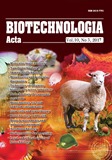SSN 2410-7751 (Print)
ISSN 2410-776X (Online)
"Biotechnologia Acta" V. 10, No 3, 2017
https://doi.org/10.15407/biotech10.03.050
Р. 50-56, Bibliography 13, English
Universal Decimal Classification: 664.15

IGRADIENT-CONTINUOUS YEAST CULTIVATION FOR THE ALCOHOL PRODUCTION FROM MOLASSES
Levandovskiy L. V., Myhailyk V. S.
Kyiv National University of Trade and Economics, Ukraine
This work objective is to find the technological conditions for the intensification of yeast growth in the gradient-continuous yeast cultivation process. Experiments on four sequential yeast chemostats (connected into a battery) demonstrated broad possibilities to influence the metabolic activity of yeast and the alcohol production depending on the content of molasses introduced into the second, third and fourth yeast generators. Adding the molasses according to the 3:2:1 scheme in quantities, which are sufficient to achieve the initial concentration of solids of 26.5 g/100 cm3 to the end of the process resulted in high accumulation of yeast in the medium (up to 99 g/dm3).
It is demonstrated that the highest ratio of economic effect of biomass synthesis from molasses sugars (88 g/100 g) is achieved when molasses is added according to the 1:2:2.5 scheme and the initial solids concentration in the medium is near 12 g/100 cm3.
Key words: yeast, ethanol, molasses.
© Palladin Institute of Biochemistry of National Academy of Sciences of Ukraine, 2017
References
1. Typical technological regulation of production molasses-alcoholic mash and pressed baking yeast: TR Ukr 18.8049 ? 2004. Kyiv: UkrNDIspyrtbioprod: Ministry of Agrarian Policy of Ukraine. 2004, 62 p. (In Ukrainian).
2. Shiyan P. L., Sosnytskiy V. V., Oliynichuk S. T. Innovative technologies of alcohol industry. Theory and practice. Kyiv: Аskaniia. 2009, 424 p. (In Ukrainian).
3. Levandovsky L. V., Bondar M. V. Features of yeast metabolism in their recirculation provided alcohol fermentation of molasses wort. Mikrobiol. zh. 2016, 78 (1), 52–61. (In Ukrainian).
4. Marynchenko V. A., Domaretskyy V. A., Shiyan P. L. Technology of alcohol. Vinnitsa “Podole. 2000”. 2003, 496 p. (In Russian).
5. Pydgorskyy V. S., Iutynska H. O., Pyrog T. P. Intensification technology of microbial synthesis: Monograph. Kyiv: Naukova dumka. 2010, 327 p. (In Ukrainian).
6. Levandovskiy L. V., Mikhailyk V. Two-product obtaining technology based on continuous gradient yeast generation. Biotechnol. acta. 2016, 9 (5), 38–44. https://doi.org/10.15407/biotech9.05.038
7. Levandovsky L. V., Nichik O. V., Yakovenko A. A. Influence of cultivation duration of alcohol yeast on the results of fermentation of molasses wort. Production of alcohol and alcoholic beverages. 2012, No 2, P. 13–15. (In Russian).
8. Levandovsky L. V., Nichik O. V., Semenyuk Yu. V. Influence of the composition of molasses wort on the effectiveness of two-product of alcohol production and baker’s yeast. Production of alcohol and alcoholic beverages. 2012, No 1, P. 11–13. (In Russian).
9. Ghorbani F., Younesi H. The kinetics of ethanol production from cane molasses by Saccharomyces cerevisiae in a batch bioreactor. Energy Sources, Part A: Recovery, Utilization and Environmental Effects. 2013, 35 (11), 1073–1083.
10. Bouallagui, H., Touhami, Y., Hanafi, N., Ghariani, A., Hamdi, M. Performances comparison between three technologies for continuous ethanol production from molasses. Biomass Bioener. 2013, V. 48, Р. 25–32.
11. De Andrade R., C?ndida Rabelo S., Maugeri Filho F., Maciel Filho R., Carvalho da Costa A. Evaluation of the alcoholic fermentation kinetics of enzymatic hydrolysates from sugarcane bagasse (Saccharum officinarum L.). J. Chem. Technology Biotechnol. 2013, 88 (6), 1049–1057.
12. Herrera W. E., Filho R. M. Development of a monitoring hybrid system for bioethanol production. Chem. Engin. Transact. 2013, V. 32, Р. 943–948.
13. Instructions on technochemical and microbiological control of alcohol production/ratified. Hosahropromom USSR 15.01.1986. N.: Agropromizdat. 1986, 400 p. (In Russian).

